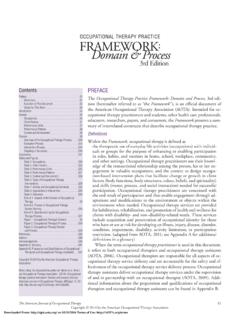Transcription of This PDF is a selection from an out-of-print volume from ...
1 This PDF is a selection from an out-of-print volume from the NationalBureau of Economic ResearchVolume Title: human capital : A Theoretical and Empirical Analysiswith Special Reference to Education (3rd Edition) volume Author/Editor: Gary S. BeckerVolume Publisher: The University of Chicago PressVolume ISBN: 0-226-04119-0 volume URL: Date: n/aPublication Date: January 1994 Chapter Title: human capital RevisitedChapter Author: Gary S. BeckerChapter URL: pages in book: (p. 15 - 28)CHAPTER IIHuman capital Revisited11.
2 IntroductionA Ryerson lecturer is supposed to tell the audience what he or she hasbeen doing to earn a living from the University. Therefore it is an appro-priate occasion for me to review what is known about human capital ,especially the progress during the quarter-century since I published abook with that title. What has been called the human capital "revolu-tion" began about three decades ago. Its pioneers include Ted Schultz,Jacob Mincer, Milton Friedman, Sherwin Rosen, and several others asso-ciated with the University of most of you, capital means a bank account, one hundred shares ofIBM, assembly lines, or steel plants in the Chicago area (especially dur-ing a Ryerson lecture).
3 These are all forms of capital in the sense thatthey yield income and other useful outputs over long periods of I am going to talk about a different kind of capital . Schooling, acomputer training course, expenditures on medical care, and lectureson the virtues of punctuality and honesty are capital too in the sense thatthey improve health, raise earnings, or add to a person's appreciation of1 I appreciate the helpful comments of Guity Nashat, Sherwin Rosen, and George Stiglerand the assistance of David human capital REVISITED literature over much of his or her lifetime.
4 Consequently, it is fully inkeeping with the capital concept as traditionally denned to say that ex-penditures on education, training, medical care, etc., are investments incapital. However, these produce human , not physical or financial, capitalbecause you cannot separate a person from his or her knowledge, skills,health, or values the way it is possible to move financial and physicalassets while the owner stays put. This embodiment of human capital inpeople is depressingly illustrated by the reactions of Hong Kong resi-dents to the takeover of Hong Kong in 1997 by China.
5 Many local peopleare busy protecting against China's policies by selling off some of theirlocal financial and physical assets in order to invest in safer foreign secu-rities and property. At the same time, however, computer experts, topmanagement, and other skilled personnel are leaving Hong Kong indroves to seek citizenship elsewhere. They cannot reduce the risk totheir human capital from China by investing only part of the humancapital abroad; they must go where their capital may seem odd now, but I hesitated a while before deciding to callmy book human capital and even hedged the risk by using a long subti-tle.
6 In the early days, many people were criticizing this term and theunderlying analysis because they believed it treated people like slaves ormachines. My, how the world has changed! The name and analysis arenow readily accepted by most people not only in all the social sciences,but even in the media. I was surprised when a few months ago BusinessWeek magazine had a cover story titled " human capital ." And moreamazing still, this has been their most popular cover story in several , I should add that the concept of human capital remains sus-pect within academic circles that organize their thinking about socialproblems around a belief in the exploitation of labor by capital .
7 It is easyto appreciate the problems created for this view by the human capitalconcept. For if capital exploits labor, does human capital exploit labortoo in other words, do some workers exploit other workers? And areskilled workers and unskilled workers pitted against each other in thealleged class conflict between labor and capital ? If governments are toexpropriate all capital to end such conflict, should they also expropriatehuman capital , so that governments would take over ownership of work-ers as well?
8 You can see why an idea developed to understand the economic andsocial world has been thrust into ideological discussions. Yet the conceptof human capital has been popular in Communist countries. My bookand those by Schultz and others on human capital are extensively usedin the Soviet Union, Eastern Europe, and China. Even before the recentEDUCATION AND TRAINING 17reforms, economists and planners there had no trouble with the conceptof investing capital in will try to avoid technical analysis and jargon, and concentrate onshowing how the analysis of investments in human capital helps in un-derstanding a large and varied class of behavior not only in the Westernworld, but also in developing countries and countries with very differentcultures.
9 My discussion follows modern economics and assumes thatthese investments usually are rational responses to a calculus of expectedcosts and Education and TrainingEducation and training are the most important investments in humancapital. My book showed, and so have many other studies since then,that high school and college education in the United States greatly raisea person's income, even after netting out direct and indirect costs ofschooling, and after adjusting for the better family backgrounds andgreater abilities of more educated people.
10 Similar evidence is now avail-able for many points in time from over one hundred countries with dif-ferent cultures and economic systems. The earnings of more educatedpeople are almost always well above average, although the gains are gen-erally larger in less-developed countries. Consider the differences in av-erage earnings between college and high school graduates in the UnitedStates during the past fifty years. After being reasonably stable at be-tween 40 and 50 percent until the early 1960s, they rose during thatdecade and then fell rather sharply.














